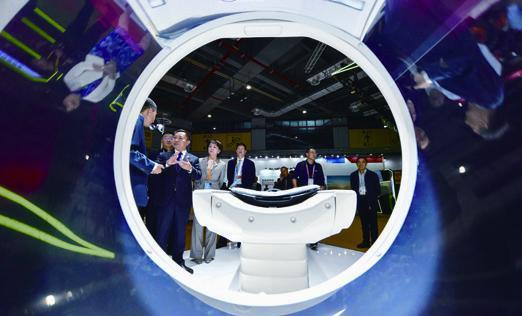Importing Demand
2019-11-18ByMichaelZakkour
By Michael Zakkour
At a time when the role and value of free trade among major nations, in relation to local, regional and global economic development, is being reevaluated and questioned, the Second China International Import Expo (CIIE), which was held in Shanghai from November 5 to 10, provided some guidance, answers and encouragement regarding the continuation of global progress made over the past 30 years.
In his opening speech, Chinese President Xi Jinping addressed the issue head on, saying, “Let us work together to build an open world economy through cooperation. As global value and supply chains continue to develop, countries are more interconnected and the integration of their economies is the order of the day.”

Joining hands
The distances among countries is getting shorter, while interactions among countries are growing, thus the probability of differences and frictions are growing as well. We need to join hands instead of letting go. We need to tear down walls, not erect them. We need to stand fi rm against protectionism and unilateralism. We need to continually bring down trade barriers, optimize global value and supply chains, and jointly foster market demand.
The Second CIIE saw a multitude of foreign companies gather to present a wide array of high-quality consumer, industrial and agricultural products to an eager audience of Chinese companies and entities seeking to buy, distribute and sell these products in China.
In a multi-year commitment to increasing the number and volume of imported goods from around the world, China made the First CIIE in November 2018 a major and tangible part of this effort, resulting in $57 billion worth of new import deals. At the Second CIIE,$71.13 billion worth of tentative deals were reached for one-year purchases of goods and services, up 23 percent.
With representatives from 181 countries, regions and international organizations and more than 3,800 companies in attendance, including makers of appliances, food and beverage products, apparel and pet food, the event offered an important opportunity for the joint public/ private development of shared economic growth. While their products may differ, the hopes of these companies and the nations they hail from are largely similar. They all understand that the opportunity to export consumer and industrial goods, and raw materials to China has never been more urgent and important, for them or for China.
In recent years, Chinese consumers have grown in number, sophistication and mobility, and are now fully integrated into the New Retail model that blends online, offl ine, technology and logistics for a new way of making, moving, selling and buying things.
While some sectors of the Chinese economy are adjusting to transition by resetting operations and expectations, retail sales of consumer goods grew 8.2 percent in the first three quarters of 2019 year on year. The bottom line is that every avenue that leads to giving consumers what they want, including foreign products and brands, must be addressed and followed.
The expo is an important place where e-commerce giants, distributors and brand owners are meeting to ensure that growing consumer demand for foreign products is met. This demand is critical to further developing the Chinese economy based on consumption and services.
According to an offi cial announcement on the CIIE website, the event is specifi cally designed to address the confluence of trade and the international relationships at the heart of trade agreements. “As an open cooperation platform for China to invite countries around the world to show their national image and engage in international trade, the CIIE is not only a product display platform for expanding imports, propelling global multilateral trade and showing achievements of economic development,but also proves to be a diplomatic arena at home for enhancing friendly exchanges and cultural exchanges among countries and regions,” it said.

“The import expo is a very important international relations tool for China. Its more than just saying that its open for business,” said Rodrigo Zeidan, an associate professor of business and finance at New York University in Shanghai. “There is this subtext that is about Chinas role in the global economy.”
In the 1990s and 2000s (and to a certain degree today as well), the biggest and most important trade event in China was the China Import and Export Fair held in Guangzhou, Guangdong Province in south China, also known as the Canton Fair. Twice a year, tens of thousands of people from all over the world gather in the city to meet with thousands of Chinese manufacturers to find the ideal products and sourcing partners for their domestic businesses.
The CIIE is a sign of how things have developed in China over the past 25 years. Consumption continues to rise and set new records; technology and innovation are driving the expansion of services and consumption; and China is an active participant and driver of global free trade with a new emphasis on imports.
Increasing demand
Hot on the heels of the closing of the Second CIIE, the most important consumer event in China took place. On November 11, the annual 11/11 online shopping festival, spearheaded by the Alibaba Group, kicked into high gear.
I spent this years festival at Alibabas headquarters in Hangzhou in Zhejiang Province, east China, to witness firsthand the blend of technology, e-commerce, logistics and entertainment that makes it the biggest consumer event in the world. Alibaba, JD.com, Kaola and other Chinese e-commerce, technology and consumer giants committed significant resources, money and thought to help ensure that more foreign consumer product and retail companies could meet the demand of Chinese consumers for goods and services.
This year, Alibaba shattered 2018s sales of $30 billion by selling $38.3 billion worth of goods. Foreign brands and retailers were at the forefront of the record-breaking day. The top-selling countries were Japan, the Republic of Korea, the United States, Australia, Germany, France, Italy, Canada and New Zealand.
This is proof that the demand for foreign products is healthy in China and that tech and e-commerce giants are playing an important role in cross-border commerce.
A commitment by Chinese companies to import foreign industrial, agricultural and hi-tech products and raw materials, combined with a robust demand for consumer products, were keys to the success of the spirit and organization of the Second CIIE.
It is hoped that the event, with its model of mixed business-to-business, governmentto-government and organization-toorganization engagement, will enable the kind of cooperation that leads to continued global economic growth and that Chinas role in that mission will be critical.
